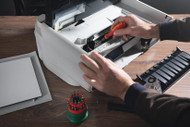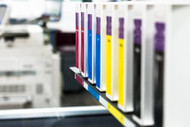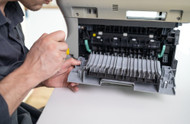Understanding Ink Cartridge Chip Technology and Compatibility
Ink cartridges play a crucial role in delivering high-quality prints, and the technology behind them has evolved significantly over the years. One important aspect of ink cartridges is the presence of a microchip, which serves various functions and ensures compatibility between the cartridge and the printer. Understanding ink cartridge chip technology and compatibility can help you make informed decisions when purchasing and using ink cartridges. Let's delve into the details.
What is an Ink Cartridge Chip? An ink cartridge chip, also known as an integrated circuit or smart chip, is a small electronic component embedded in the ink cartridge. It contains information about the cartridge, such as ink levels, cartridge identification, and communication protocols. The chip communicates with the printer, providing essential data for proper ink delivery and monitoring.
Functions of Ink Cartridge Chips:
- Ink Level Monitoring: The chip tracks the ink levels in the cartridge and communicates this information to the printer. This allows the printer to display accurate ink level indicators, alerting you when it's time to replace the cartridge.
- Cartridge Identification: The chip contains specific information about the cartridge model and manufacturer. When you insert a cartridge into the printer, the chip's data is read by the printer, ensuring that it is compatible with the printer model.
- Authentication and DRM: Some ink cartridges feature authentication mechanisms to ensure they are genuine and not counterfeit. The chip contains authentication codes that the printer verifies, preventing the use of unauthorized or counterfeit cartridges. Additionally, Digital Rights Management (DRM) technology may be incorporated into the chip to protect against patent infringement.
- Firmware Updates: In some cases, ink cartridge chips can receive firmware updates from the printer manufacturer. These updates can enhance performance, improve compatibility, or address any known issues with the cartridge.
Compatibility Considerations: Ink cartridge chip technology plays a crucial role in determining cartridge compatibility with specific printers. Printer manufacturers design their printers to work with specific chip formats and protocols. It's important to understand the compatibility requirements before purchasing ink cartridges. Here are a few key considerations:
- Genuine vs. Third-Party Cartridges: Genuine ink cartridges are specifically designed by the printer manufacturer for their printers and are guaranteed to be compatible. Third-party cartridges, while often more affordable, may not have the same chip technology or be recognized by the printer. Carefully research compatibility information or consult with the manufacturer before using third-party cartridges.
- Printer Firmware Updates: Printer manufacturers occasionally release firmware updates that can impact cartridge compatibility. Before installing firmware updates, ensure that your ink cartridges are compatible with the updated firmware. In some cases, third-party cartridges may become incompatible after a firmware update.
- Region-Specific Cartridges: Some printers require region-specific ink cartridges due to differences in chip technology, ink formulation, or printer setup. Ensure that the cartridges you purchase are intended for your region to ensure compatibility.
- Chip Resetting or Refilling: If you're refilling or resetting an ink cartridge, it's important to understand that simply refilling the ink may not reset the chip's ink level information. The chip may still indicate that the cartridge is empty, even if it has been refilled. In such cases, you may need to consider using a chip rosette or follow specific instructions provided by the cartridge manufacturer.
Understanding ink cartridge chip technology and compatibility is essential for ensuring the smooth operation of your printer and obtaining high-quality prints. It's advisable to purchase genuine cartridges or choose reputable third-party options that are known to be compatible with your printer. Always refer to the printer's user manual or consult the manufacturer for specific compatibility information and recommendations.





